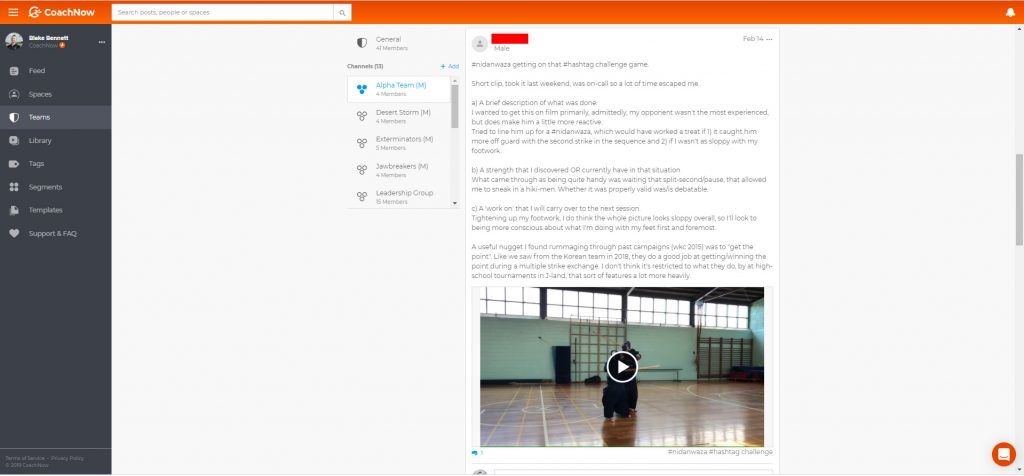With social distancing and lock-down restrictions wreaking havoc in the sports world, any form of face-to-face interaction in the immediate future is uncertain. We hear from Blake Bennett, the coach of the New Zealand Men’s Kendo Team focusing on the forthcoming 18th World Kendo Championship scheduled to take place in Paris during May 2021.
While the knock-on effect of the virus has long-term implications, we in the management team are currently considering our ‘Plan B’ for selection, events and squad trainings. While we recognise that much of what is to come is out of our control, we must consider alternative means to keep our athletes engaged, motivated and focused. In this article, I would like to share some of the processes we are using to keep athletes driven and purposeful with their days spent in isolation.
Some quick context
Kendo is a form of Japanese sword fighting. The New Zealand Kendo Team, also known as the ‘Wolves,’ share similar challenges with many other national-level representative teams. Our athletes’ participation in and travel to events is self-funded, and our representative teams draw from athletes based throughout New Zealand, with a handful of athletes also based in the UK, Korea, Japan and Australia. Within this setting, alternative measures to connect our group to ensure alignment in training focus, team values, and communication were a must from the beginning of our current campaign in mid-2019.
Given how recent circumstances have significantly impacted our 2020/21 preparation phases, what follows in this article is a rundown of the processes we have set in motion to keep our athletes doing what they can do to maintain focus, motivation, and indeed, feel prepared during an otherwise uncertain time. While the environment I describe below was initially designed for a high performance climate, there is certainly scope for community coaches to trial and tweak to suit their own unique contexts.
Find a platform that works for your team
To achieve our initial goal of overcoming geographical separation from the beginning of our campaign in mid-2019, we opted to use the remote coaching ‘app’ termed CoachNow. Before coming to the decision to use CoachNow, our research showed that there is a plethora of other similarly purposed, low- or no-cost platforms. The platform you select can be as simple as a Facebook page, a WhatsApp group, or the more sport-specific (and sometimes paid) platforms like CoachNow or TrueCoach. However, in choosing CoachNow we’ve recognised three distinct advantages of having a standalone platform for coaching over more generic messaging services (e.g. Facebook Messenger or WhatsApp):
- Functionality – CoachNow allows us to easily divide the squad of 40 people into smaller groups for manageable interactions (see more on this below).
- Specificity – in contrast to a Facebook page, CoachNow is a dedicated platform specifically for coaches and athletes. In this way, it has helped us to minimise distractions and focus the athletes’ attention when they sign in.
- Professionalism – as above, using a dedicated platform helps to sharpen athletes’ focus. This also extends to the management and coaching team, and has contributed to an improved sense of professionalism overall.

Connecting the Wolves in a one-stop-shop like CoachNow was a pre-pandemic decision; however, in recognising that the social distancing restrictions for the remainder of 2020 are an unknown, this is arguably an essential step for squads and teams now (as it has become for most learning institutions, too).
ProTip: based on our experience thus far, the ability to create small groups within the larger group has been a game changer. For instance, placing athletes into ‘spaces’ allows them to interact with each other, provide support, and ultimately develop connections in smaller (read: manageable) clusters. Each ‘space’ has a unique name (i.e. the ‘Exterminators’ or the ‘Slayers’) as an identifier and consists of four to five athletes – one of whom is in a leadership position charged with keeping the interactions ongoing, structured and lively. Naturally, the coaching team can and does post to the wider group; however assigning leadership roles within each ‘space’ of athletes has proven to be an excellent way to promote autonomy and a sense of relatedness to fellow teammates – some of whom are yet to meet face-to-face given their country of residence.
Get athletes involved and interacting on the platform
It is critical that we keep our athletes involved in the learning process. Although the option always exists for the coaching team to post YouTube videos and the like, we ask our athletes to go out and find the resources, images, and ideas that resonate with them. For instance, the Wolves are encouraged to access the resources available to them on the world wide web, post it, and deconstruct this content with their respective groups. Here, we are encouraging ownership and accountability of their own learning; and importantly, with the guidance of the group’s leadership, athletes are actively contributing to the collective knowledge of the team. Each athlete brings their own level of understanding to these tasks and are reassured that each perspective is valid and important. After all, there is more than one way to skin a cat!
Give athletes regular #Hashtag challenges
A simple way to facilitate regular and focused interaction is through, what we term, the “#hashtag challenge” – where the ‘#hashtag’ is an area, topic, or strategy in kendo that we (at last observation) are in need of developing (i.e. our ‘work ons’), or are able to leverage on the court (i.e. our ‘strengths’). To this end, the Wolves are issued a fortnightly challenge (read: task) to search out a YouTube clip that best demonstrates the hashtag theme.
Prior to lockdown, many challenges were technique-based and self-focused – for instance, the “#counterattack” challenge asked athletes to record themselves at training/in local competitions and identify an instance where they had demonstrated (or could have demonstrated) a counterattack. Athletes were given a framework of questions to deconstruct their performance such as: 1. what was done well (my strength)?; 2. what needs some work (my work on)?; and 3. what are my next steps (my strategy for next time)?
Currently, however, we have taken the opportunity to shift our focus to the opposition. At the time of writing, the Wolves are searching out examples of team event strategy – specifically, how fighters change (or otherwise) their approach given changes on the score board. For instance, once a point is scored, does the fighter who is one point up continue to attack (i.e. “hunt”) or does he/she “hold”? This is the #HuntorHold challenge. Accordingly, the questions for athletes to consider in their deconstruction include: 1. what are the stand-out characteristics of this fighter in comparison to someone in the latter half of the event?; 2. once a point was scored, what differences do you notice in the way the fighters handle themselves (i.e. does one ramp up, does the other hold back)?; and 3. given your style, strengths and work ons, where do you see yourself in the team line-up, and why?


By encouraging athletes to see, hear, and think about the types of strategies that others are using in the international competitive arena, there is increased consideration for the potential value of these tactics in their own development – and above all, they are engaging at more than a physical level in the learning process.
Take the opportunity to focus on non-physical content
As was the case pre-pandemic, the internet provides countless opportunities to access workouts that can be performed either inside the house or in the back garden. We are also lucky enough to have a strength and conditioning coach developing kendo-specific routines. While this is an excellent alternative to the face-to-face training for now, there are still a number of skillsets that the Wolves can and need to work on during this unique phase in their preparation. One such skillset is the ability to draw on mental skills such as imagery (and/or visualisation) in their performance.
Based on my own experiences as an athlete, mental imagery was at times tougher than the physical part of competition. I understood and appreciated the value of imagery to strengthen my performance and control my pre-competition nerves. Yet, despite my dabbling in psychological skills training, I struggled with creating the picture of a successful performance in my mind’s eye. Unsurprisingly, the same feedback has come from some of the athletes in the Wolves early in our campaign.
What to do? Cue the #hashtag challenges. We are finding that as the Wolves access, digest, deconstruct, debate, and deliberate other high level kendo performances (i.e. via YouTube clips), they are simultaneously amassing a stockpile of clear visual images that they can draw on in the process of mental skills training. Through the deconstruction process with each #hashtag challenge, athletes begin to see themselves performing that technique or strategy; and therefore the inclusion of mental imagery – in lieu of physical training – becomes a more manageable shift for athletes as we progress.
In conclusion
At one level, the approach we have taken allows us to continue to prepare for the World Kendo Championships. However, given the numerous uncertainties all sport teams are facing in the coming weeks, months, and years, it is hoped that the provision of a platform from which to connect with teammates, and engage in focused, autonomous, and thoughtful learning interactions will go some way in making the most of a difficult situation.
As mentioned earlier, the New Zealand ‘Wolves’ share the same limitations as numerous other sports teams: that is, we are self-funded and have limited opportunities to train with each other (especially now). Therefore, the processes described here are offered as possible, and I hope, useful, alternatives to face-to-face coaching in a range of different contexts.







